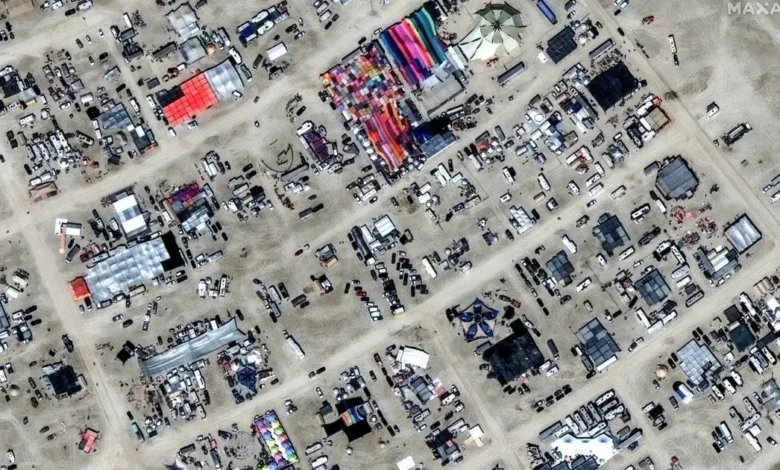Flooding traps thousands at Burning Man festival in Nevada desert, one death reported

An unusual late-summer storm turned a week-long counterculture festival into a muddy mess with tens of thousands of partygoers stuck in foot-deep mud and no working toilets in the northern Nevada desert in the US, but some Burning Man partygoers said Sunday that their spirits remained unbroken.
For the latest headlines, follow our Google News channel online or via the app.
The annual gathering in the Black Rock Desert about 110 miles (177 kilometers) north of Reno attracts nearly 80,000 artists, musicians and activists for a mix of wilderness camping and avant-garde performances.
Disruptions are part of the event’s recent history: Organizers had to temporarily close entrances to the festival in 2018 due to dust storms, and the event was twice canceled altogether during the pandemic.
More a half-inch of rain fell at the festival site on Friday, the National Weather Service in Reno said, with more coming Saturday and Sunday, and organizers closed the festival to vehicles after one death was reported. Officials provided no details of the fatality.
The closures came just before a large wooden effigy was supposed to have been burned Saturday night. Organizers said that all burning had been postponed, and authorities were working to open exit routes by the end of the Labor Day weekend.
“We are a little bit dirty and muddy but spirits are high. The party still going,” said Scott London, a Southern California photographer, adding that the travel limitations offered “a view of Burning Man that a lot of us don’t get to see.”
Officials said late Saturday they didn’t yet know when the roads would “be dry enough for RVs or vehicles to navigate safely,” but they were hopeful vehicles could depart by late Monday if weather conditions improved.
With their party closed to motorized traffic, attendees trudged through mud, many barefoot or with plastic bags on their feet. Revelers were urged to conserve supplies and most remained hunkered down, hoping roads opened as early as Monday. A few, however, managed to walk several miles to the nearest town or catch a ride there.
Celebrity DJ Diplo posted a video to Instagram on Saturday evening showing him and comedian Chris Rock riding in the back of a fan’s pickup truck. He said they had walked six miles through the mud before hitching a ride.
“I legit walked the side of the road for hours with my thumb out,” wrote Diplo, whose real name is Thomas Wesley Pentz.
The event is remote on the best of days, and emphasizes self-sufficiency – meaning most people bring in their own food, water and other supplies.
Those who remained Sunday described a resilient community making the most of the muddy conditions: Many posted selfies of themselves covered in mud, dancing or splashing in the makeshift lakes.
“We have not witnessed any negativity, any rough times,” Galeani said. “Some people … were supposed to leave a few days ago so they’re out of water or food. But I am an organizer so I went around and found more water and food. There is more than enough here for people. We just have to get it to everyone.”
London, the southern California photographer who was attending his 20th Burning Man and just came out with a book on the festival, “Burning Man: Art On Fire,” spent much of Saturday walking barefoot across the site, which is about 5 square miles. He said that the biggest challenge was logistics, since no vehicles could traverse the site, supplies could not be brought in and most people could not leave.
“We are a little bit dirty and muddy but spirits are high. The party still going,” he said, adding the travel limitations offered “a view of Burning Man that a lot of us don’t get to see.”
“Usually it’s very crowded with art cars, bikes and people all over the place but yesterday it was like an abandoned playground,” he added.
Rebecca Barger, a photographer from Philadelphia, arrived at her first Burning Man on Aug. 26 and was determined to stick it out through the end.
“I’m not leaving until both ‘The Man’ and ‘The Temple’ burn,” Barger said, referring to the wooden effigy and wooden structure that are traditionally torched during the event’s last two nights.
She said one of the biggest concerns has been the lack of toilet options, since the trucks that normally arrive to clean out the portable toilets multiple times a day haven’t been able to reach the site since Friday’s rainstorm. Some revelers said trucks had resumed cleaning on Sunday.
To prevent her shoes from getting stuck in the muddy clay, Barger says she put a plastic bag over each of her shoes and then covered each bag with a sock. Others were just barefoot.
“Everyone has just adapted, sharing RVs for sleeping, offering food and coffee,” Barger said. “I danced in foot-deep clay for hours to incredible DJs.”
Ed Fletcher of Sacramento, a longtime Burning Man attendee, arrived in Black Rock City over a week ago to start setting up. When the rain hit, he and his campmates threw a party and “danced the night away” in their muddy shoes.
“Radical self-reliance is one of the principles of Burning Man,” he said. “The desert will try to kill you in some way, shape or form.”
The Pershing County Sheriff’s Office but offered few details of the death, as the investigation continued, including the identity of the deceased person or the suspected cause.
On their website, organizers encouraged participants to remain calm and suggested that the festival is built to endure conditions like the flooding. They said cellphone trailers were being dropped in several locations Saturday night and that they would be briefly opening up internet overnight. Shuttle buses were also being organized to take attendees to Reno from the nearest town of Gerlach, a walk of about five miles (eight kilometers) from the site.
“Burning Man is a community of people who are prepared to support one another. We have come here knowing this is a place where we bring everything we need to survive,” the organizers said in a statement. “It is because of this that we are all well-prepared for a weather event like this.”
The event began on Aug. 27 and had been scheduled to end Monday, according to the US Bureau of Land Management, which oversees the Black Rock Desert, where the festival was held.
John Asselin, a spokesperson for the Bureau of Land Management, said he had seen “a steady stream” of vehicles leaving the festival site.
“People are getting out,” he said.









